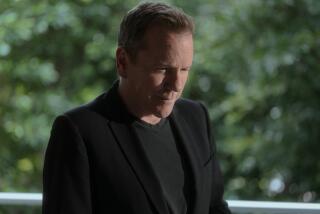Director Edward Dmytryk Dies; Testified in Blacklist Era
- Share via
Edward Dmytryk, the once-influential director who made his mark in the 1940s with noirish thrillers such as “Murder My Sweet” but whose work was eclipsed by his decision to name names before the House Un-American Activities Committee, died Thursday night at his home in Encino. He was 90.
Dmytryk, one of the last surviving members of the so-called Hollywood 10 (just Ring Lardner Jr., now 83, remains), was the only one of their number to break ranks and testify about Communist influence in the film industry. After his testimony in 1951, while other filmmakers who had refused to testify suffered under the blacklist, Dmytryk made some of the top movies of the 1950s and worked with such stars as Marlon Brando, Montgomery Clift, Elizabeth Taylor and Humphrey Bogart. But some critics said his work had become soulless and bloated--as if, they said, he’d sold out his talent when he betrayed his friends.
Dmytryk would later say that his testimony gave the committee only names of people it already had. But many people never forgave him. Among them was Adrian Scott, who produced Dmytryk’s best movies of the 1940s.
“Adrian’s position was simple,” said his widow, Joan. “He had contempt for informers and he never spoke to them.”
Joan Scott also came under suspicion in those years because of her work as executive director of the television writers’ union. She still harbors bitter feelings.
“I hope he had a bad life,” she said of Dmytryk.
That life started in Grand Forks, British Columbia, where Dmytryk was born to Ukrainian immigrant parents. After his mother died when he was young, his father married again and the family moved to San Francisco. Dmytryk left home at 14 and relocated to Los Angeles, where he attended Hollywood High School. He received a scholarship to Caltech, but dropped out after his freshman year. He found work as a messenger at Paramount Studios in Hollywood, where he eventually rose to the rank of film editor.
Career in High Gear When Red Scare Hit
His career was in high gear in 1947 when the Communist scare jolted Hollywood. Highly regarded for sinewy thrillers in which he made striking and innovative use of shadows and light, he had just released the atmospheric “Crossfire,” the first serious movie treatment of anti-Semitism. He’d made the well-regarded “Cornered” in 1945 and before that “Murder My Sweet,” one of the seminal films noir, which revived the career of crooner Dick Powell, who played tough-guy private eye Philip Marlow.
Nineteen filmmakers were subpoenaed by HUAC to testify in 1947. The Hollywood 10 made a pact to refuse to testify on constitutional grounds of freedom of speech. Their careers shattered, they sought work elsewhere or under pseudonyms. Dmytryk moved to England, where he made films. But when his visa expired in 1951 he returned to the United States and was arrested. After serving six months in prison, he agreed to testify.
He always contended that he had grown disenchanted with the Communist Party well before then--he later said he left the party in 1945--and hence he was suffering for a cause he no longer believed in. His efforts to defend his testimony didn’t keep him from becoming--like Elia Kazan, another director who testified--a pariah among Hollywood liberals.
“They all were victims, those who testified and those who didn’t,” said Michael Collins, a documentary filmmaker whose father, screenwriter Richard Collins, testified, and whose mother, actress Dorothy Comingore, refused and was blacklisted.
“I liked Eddie Dmytryk, no matter what his politics,” said Collins, who as a child knew the director and who interviewed him for CNN earlier this year. “He treated me with respect and I thought he made some wonderful movies.”
After much angry debate, Kazan was awarded an honorary Oscar this year for his body of work. Dmytryk never got such validation, and indications are that he was hurt by the ostracism.
In 1988, at a Barcelona Film Festival symposium about the Hollywood blacklist, three other former members of the Hollywood 10 refused to share the podium with him.
“When I die,” Dmytryk told an interviewer a decade ago, “I know the obits will first read, ‘one of Hollywood’s Unfriendly 10,’ not ‘director of “The Caine Mutiny,” “The Young Lions” and “Raintree County” and other films.’ ”
After he testified, Dmytryk’s career slowly took off again. First he did small-budget movies for Stanley Kramer, but he went on to make big-budget, less personal movies that were unlike anything he’d made before.
Despite the criticisms directed at his later work, the second half of his career boasts some praiseworthy achievements. Bogart delivered an intense performance in “The Caine Mutiny” as a ship’s disintegrating commander. And “Mirage,” despite the flatness of the compositions, plays tricks with narrative and shows off the influence of Dmytryk’s early experience as an editor. It also featured one of Walter Matthau’s first big roles.
Although much of his later work is often criticized, film historian Neal Gabler said that even Dmytryk’s least impressive films of that period are fascinating when viewed against the background of the blacklist.
In “The Caine Mutiny,” for instance, Bogart’s paranoid Captain Queeg, whose crew members rebel, gains a bit of vindication by the end, Gabler said. And in movies such as “Raintree County” and “The Young Lions” there is a recurring theme of obsessiveness that can take on a political reading when viewed in light of Dmytryk’s experiences.
“I think that informing informed the movies in an interesting way,” Gabler said.
After “Bluebeard” in 1972, Dmytryk found it impossible to get backing to make more movies. He turned to a life of teaching and writing, but even then he continued to harbor hopes of one day putting together the financing to make more films.
His autobiography, “It’s a Hell of a Life, but Not a Bad Living,” was published in 1979 while he was teaching at the University of Texas. He later wrote another autobiography, “Odd Man Out: A Memoir of the Hollywood Ten,” and taught at USC.
He is survived by his wife, Jean Porter; a son by a first marriage, Michael; two daughters, Rebecca and Victoria; and three grandchildren.
Funeral arrangements were pending.


